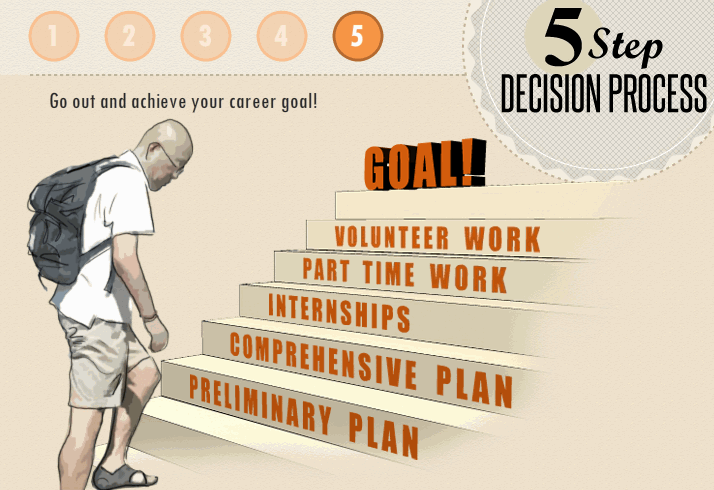
The only way to do great work is to love what you do. If you haven’t found it yet, keep looking. Don’t settle. –Steve Jobs, cofounder and CEO of Apple
Learning Objectives
By the end of this section, you will be able to:
- Differentiate between “job” and “career”
- Explain the five-step process for choosing a career, which includes aligning your personal interests and skills with appropriate fields
- Identify sources for learning more about specific careers
- Learn about Tommy Wiseau’s early influences
Pursuing Your Professional Interests
One of the most widely known and successful American entrepreneurs of all time is Steve Jobs. He is best known as the cofounder, chairman, and chief executive officer of Apple, Inc. He also cofounded Pixar Animation Studios, and he was a member of the board of directors of the Walt Disney Company. Four hundred eighty-four inventions bear Jobs’s name.
From early on in his life, Jobs was interested in electronics. When he was thirteen, for instance, he worked at the Hewlett Packard factory, which developed hardware and software components. Jobs later reflected on how he landed this job when he called Mr. Hewlett to ask for parts for an electronics project: “[Hewlett] didn’t know me at all, but he ended up giving me some parts and he got me a job that summer working at Hewlett-Packard on the line, assembling frequency counters . . . well, assembling may be too strong. I was putting in screws. It didn’t matter; I was in heaven.”
Jobs’s electronics and computing career quickly unfolded as he pursued his passion for creating and promoting computing products. At age nineteen, he was a technician for Atari, a leading electronics, gaming and home-computer corporation. By twenty-one, he and his two partners had formed Apple, Inc. At thirty-four, he was named “Entrepreneur of the Decade” by Inc. magazine. And at fifty-two, he was inducted into the California Hall of Fame by Governor Arnold Schwarzenegger.
All in all, Jobs was relentless about pursuing his interests and passions. The products he and his associates developed have transformed modern culture, including the iMac, iTunes, Apple Stores, the iPod, the iTunes Store, the iPhone, the App Store, the iPad, the Mac OS, and the Mac OS X.
Perhaps Steve Jobs never had a job he didn’t love. But he always had a career: pioneering the personal computer revolution.
This story of Steve Jobs’s professional pursuits illustrates a dream, a goal, and an ambition that many college students share: to be successful in earning money and finding personal satisfaction in employment.
In this section, we explore strategies that can help you chart your professional path and also attain ample reward. We begin by comparing and contrasting jobs and careers. We then look at how to match up your personal characteristics with a specific field or fields. We conclude by detailing a process for actually choosing your career. Throughout, you will find resources for learning more about this vast topic of planning for employment.
Job vs. Career
What is the difference between a job and a career? Do you plan to use college to help you seek one or the other?
There is no right or wrong answer, because motivations for being in college are so varied and different for each student. But you can take maximum advantage of your time in college if you develop a clear plan for what you want to accomplish. The table below shows some differences between a job and a career.
| JOB | CAREER | |
| Definitions | A job refers to the work a person performs for a living. It can also refer to a specific task done as part of the routine of one’s occupation. A person can begin a job by becoming an employee, or by volunteering, for example, by starting a business or becoming a parent. | A career is an occupation (or series of jobs) that you undertake for a significant period of time in your life—perhaps five or ten years, or more. A career typically provides you with opportunities to advance your skills and positions. |
| Requirements | A job you accept with an employer does not necessarily require special education or training. Sometimes you can get needed learning “on the job.” | A career usually requires special learning—perhaps certification or a specific degree. |
| Risk-Taking | A job may be considered a safe and stable means to get income. But jobs can also quickly change; security can come and go. | A career can also have risk. In today’s world, employees need to continually learn new skills and to adapt to changes in order to stay employed. Starting your own business can have risks. Many people thrive on risk-taking, though, and may achieve higher gains. It all depends on your definition of success. |
| Duration | The duration of a job may range from an hour (in the case of odd jobs, for example,) to a lifetime. Generally a “job” is shorter-term. | A career is typically a long-term pursuit. |
| Income | Jobs that are not career oriented may not pay as well as career-oriented positions. Jobs often pay an hourly wage. | Career-oriented jobs generally offer an annual salary versus a wage. Career-oriented jobs may also offer appealing benefits, like health insurance and retirement. |
| Satisfaction and contributing to society | Many jobs are important to society, but some may not bring high levels of personal satisfaction. | Careers allow you to invest time and energy in honing your crafts and experiencing personal satisfaction. Career pursuits may include making contributions to society. |
In summary, a job lets you enjoy at least a minimal level of financial security, and it requires you to show up and do what is required of you. In exchange, you get paid.
A career, on the other hand, is more of a means of achieving personal fulfillment through the jobs you hold. In a career, your jobs tend to follow a sequence that leads to increasing mastery, professional development, and personal and financial satisfaction. A career requires planning, knowledge, and skills, too. If it is to be a fulfilling career, it requires that you bring into play your full set of analytical, critical, and creative thinking skills. You will be called upon in a career to make informed decisions that will affect your life in both the short term and the long term.
The following video gives explicit, textbook-style distinctions between the terms job, work, and career. You may especially appreciate this video if English is a second language for you or if you are a first-generation college student.
The next video takes a different look at jobs and careers. The speaker discusses the more affective, emotional aspects of pursuing a career. His emphasis is on the importance of being passionate about your work.
Whether you pursue individual jobs or an extended career or both, your time with your employers will always comprise your individual journey. May your journey be as enjoyable and fulfilling as possible!
The Five-Step Process for Choosing Your Career
As your thoughts about career expand, keep in mind that over the course of your life, you will probably spend a lot of time at work—thousands of hours, in fact. According to the Bureau of Labor Statistics, the average workday is about 8.7 hours long, and this means that if you work 5 days a week, 50 weeks a year, for 35 years, you will spend a total of 76,125 hours of your life at work. These numbers should convince you that it’s pretty important to enjoy your career!
If you do pursue a career, you’ll find yourself making many decisions about it. Is this the right job for me? you may ask. Am I feeling fulfilled and challenged? Does this job enable me to have the lifestyle I desire? It’s important to consider these questions now, whether you’re just graduating from high school or college, or you’re returning to school after working for a while.
Choosing a career—any career—is a unique process for everyone, and for many people the task is daunting. There are so many different occupations to choose from. How do you navigate this complex world of work?
The California Community Colleges Chancellor’s Office has identified a five-step decision process that will make your career path a little easier to find. Below are the steps:
- Get to know yourself
- Get to know your field
- Prioritize your “deal makers” and rule out your “deal breakers”
- Make a preliminary career decision and create a plan of action
- Go out and achieve your career goal
Step 1: Get to Know Yourself
Get to know yourself and the things you’re truly passionate about.
- Gather information about your career-related interests and values
- Think about what skills and abilities come naturally to you and which ones you want to develop
- Consider your personality type and how it you want it to play out in your role at work
The following video has some good ideas for ways of matching your personality and skills with a career. You can download a transcript of the video here.
This next video looks at the connection between childhood interests and career options. Several successful entrepreneurs and employees share stories about how they turned childhood interests into careers that suited them well. Learn how listening to your inner child can help you find the right career.
Before moving on to step 2, you may wish to review the online surveys in the Personal Identity module, especially the Student Interest Survey for Career Clusters, which is available in both English and Spanish. Yet another survey is the Career Assessment Test. All can help you align career interests with personal qualities, traits, life values, skills, activities, and ambitions.
Ultimately, your knowledge of yourself is the root of all good decision-making and will guide you in productive directions.
Step 2: Get to Know Your Field
Get to know your field. You’ll want to investigate the career paths available to you. One of the handiest starting points and “filters” is to decide the level of education you want to attain before starting your first or your next job. Do you want to earn an associate’s degree, a bachelor’s degree, a master’s degree, or a doctorate or professional degree?
Step 3: Prioritize Your Deal Makers
Prioritize your deal makers and rule out your deal breakers. Educational requirements aren’t the only criteria that you will want to consider. Do you want to work outside or in an office? In the country or a city? In a big or small organization? For public organization or a private company? What type of industry is interesting to you? What role do you see yourself playing in the organization?
Step 4: Make a Preliminary Career Decision
Make a preliminary career decision and create a plan of action. Now that you have an idea of who you are and where you might find a satisfying career, how do you start taking action to get there? Some people talk to family, friends, or instructors in their chosen disciplines. Others have mentors in their lives with whom to discuss this decision. Your college has career counselors and academic advisers who can help you with both career decision-making and the educational planning process. But be advised: You’ll get the most from sessions with your counselor if you have done some work on your own.
Get started by using the Career Café or the Career Zone. Barbara Sher, speaker, career/lifestyle coach, and best-selling author, once wrote, “Find a career that you love and you will never work another day in your life.”
Step 5: Go out and Achieve Your Career Goal
Go out and achieve your career goal! Now it’s time to take concrete steps toward achieving your educational and career goals. This may be as simple as creating a preliminary educational plan for next semester or a comprehensive educational plan that maps out the degree you are currently working toward. You may also want to look for internships, part-time work, or volunteer opportunities that help you test and confirm you preliminary career choice. Your college counselor can help you with this step, as well.
Your work experiences and life circumstances will undoubtedly change throughout the course of your professional life, so you may need to go back and reassess where you are on this path in the future. But no matter if you feel like you were born knowing what you want to do professionally, or you feel totally unsure about what the future holds for you, remember that with careful consideration, resolve, and strategic thought, you can find a career that feels rewarding.
This isn’t necessarily an easy process, but you’ll find that your goals so much more tangible once you’ve set a preliminary career goal. Don’t forget: There is always support for you. Ask for any help you need!
Activity: Take the CAREERLINK Inventory
Objectives
- Formally assess your aptitudes, interests, temperaments, physical capacities, preferred working conditions and career preparation time using the CareerLink Inventory instrument.
Directions
- Access the CAREERLINK Inventory, add your name, and then click on the “Aptitudes” frog icon to begin the inventory. The CAREERLINK Inventory is designed to match the way you see yourself—your interests, aptitudes, temperaments, physical capacities, preferred working conditions, and desired length of preparation for employment–with available career information from the United States Department of Labor. The information you provide about yourself will produce a career profile showing to what extent your self-identified characteristics and preferences match those considered significant in 80 career clusters.
- Your responses to the items contained in this inventory should reflect your honest self-judgments in order to provide you with meaningful career information. If you are unsure about a particular response, please answer as accurately as possible.
- When you complete the inventory, review your personalized Career Inventory Results.
- Write a 750-word reflection discussing the results of the inventory. Use the guidelines, below, to guide you.
To help you develop your reflections, you may want to consider the following:
- What were your highest career-area clusters?
- Review the work performed, worker requirements, sample occupations, related clusters, and response summary (this will make sense to you once you complete the inventory). Do the results of the inventory surprise you?
- Do you believe the Careerlink Inventory produced accurate or inaccurate suggestions for you?
- Did you learn anything new about your career interests?
- What insights from the inventory results might you apply to your life?
- Follow your instructor’s directions for submitting this assignment.
The Bureau of Labor Statistics indicates that the average worker currently holds ten different jobs before age forty. This number is projected to grow. A prediction from Forrester Research is that today’s youngest workers will hold twelve to fifteen jobs in their lifetime.
What jobs are in store for you? Will your work be part of a fulfilling career? What exciting prospects are on your horizon?
Candela Citations
- Image of outdoor information fair. Authored by: Buyerlerdeqalardim. Located at: https://commons.wikimedia.org/wiki/File:Career_fair.JPG. License: CC BY-SA: Attribution-ShareAlike
- Difference between Job, Work, and Career. Authored by: Espresso English. Located at: https://youtu.be/eNcl9d8x7yk. License: CC BY: Attribution
- Introduction to Career Exploration for Success. Authored by: Ronda Dorsey Neugebauer and Zach Varpness. Provided by: Chadron State College. Located at: http://Kaleidoscope%20Open%20Course%20Initiative. License: CC BY: Attribution
- Choosing Your Career. Provided by: California Community Colleges Online Education. Located at: https://apps.3cmediasolutions.org/oei/09-Career-Planning/story.html. License: CC BY: Attribution
- Job vs Career - Think about a long time career. Authored by: els gcr. Located at: https://youtu.be/Fc7MvWOXj7c. License: All Rights Reserved. License Terms: Standard YouTube License
- Matching your skills to a career. Authored by: WWLP-22News. Located at: https://youtu.be/I-HLJxYAKbQ. License: All Rights Reserved. License Terms: Standard YouTube License
- Childhood Interests Can Help You Find the Right Career. Authored by: Hire Story. Located at: https://youtu.be/6-R0lW_Swio. License: All Rights Reserved. License Terms: Standard YouTube License
- College Success. Authored by: Linda Bruce. License: CC BY: Attribution




![PowerPoint Slide: Numbers 1-5 appear in orange circles at the top, “3” being highlighted; title on top right is "5 Step Decision Process." Text at top reads Prioritize your “dealmakers” and rule out your “deal breakers.” A circle bottom left reads “Decide what you WANT,” with “what role?” just below. To the right are four simple drawings in a grid: OUTSIDE or OFFICE [image of beach], BIG or SMALL [image of bar chart with rising arrow], COUNTRY or CITY [image of path between house and city skyline], and PUBLIC or PRIVATE [image of figure wearing hat and nametag next to figure wearing a tie].](https://s3-us-west-2.amazonaws.com/courses-images-archive-read-only/wp-content/uploads/sites/1110/2016/01/02024927/Step-3-Prioritize-dealmakers.gif)

